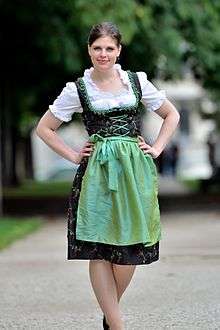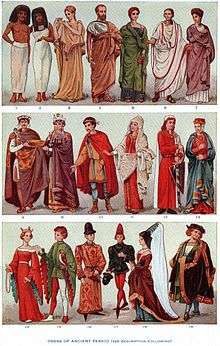Bodice
A bodice ( /ˈbɒdɪs/) is an article of clothing for women and girls, covering the body from the neck to the waist. The term typically refers to a specific type of upper garment common in Europe during the 16th to the 18th century, or to the upper portion of a modern dress to distinguish it from the skirt and sleeves. The term comes from pair of bodies (because the garment was originally made in two pieces that fastened together, frequently by lacing).
.jpg)
History

In modern usage, bodice typically refers to an upper garment that has removable sleeves or no sleeves, often low-cut, worn in Europe from the 16th century to the 18th century, either over a corset or in lieu of one. To achieve a fashionable shape and support the bust, the bodice was frequently stiffened with bents (a type of reed), or whalebone. The bodice was different from the corset of the time because it was intended to be worn over the other garments. In earlier periods, bodices and corsets were laced in spiral fashion, with one continuous lace. In later periods, both were laced like the modern tennis shoe, with eyelets facing one another. This was more convenient for women who had to dress themselves.
In historical usage, particularly in Victorian and early 20th century fashion, a bodice (in earlier sources, body) instead indicates the upper part of a dress that was constructed in two parts (i.e., with separate skirt and bodice, such as a ballet tutu), but of matching or coordinating fabric with the intention of wearing the two parts as a unit. In dressmaking, the term waist (sometimes given as "dress waist" to distinguish it from a shirtwaist) was also used. During wear, the parts might be connected by hooks and eyes.[1] This construction was standard for fashionable garments from the 18th century until the late 19th century, and had the advantages of allowing a voluminous skirt to be paired with a close-fitting bodice, and of allowing two or more bodices to be worn with the same skirt (e.g., a high-necked bodice and a low-necked bodice allowed the same skirt to serve for both daywear and evening wear). One-piece construction became more common after 1900 due to the trend for looser, more simply-constructed clothing with narrower skirts.
One mid-19th-century style included the Agnes Sorel bodice, named after 15th-century royal mistress Agnes Sorel. This style was a day wear bodice, with a square cut neckline that had a high front and back and bishop sleeves.[2]
Bodice continues in use to refer to the upper portion (minus the sleeves) of a one- or two-piece dress. The bodice of a dress was called the corsage in the 19th century.
Today

Bodices survive into modern times in the traditional or revived folk dress of many European countries (see, for example, Austrian dirndl or the Aboyne dress worn by Scottish highland dancers). They are also commonly seen today at Society for Creative Anachronism events or a Renaissance Fair.[3]
See also
- Bodice ripper
References
- Dressmaking, Up to Date. New York: The Butterick Publishing Company. 1905. pp. 75.
- Cumming, Valerie; Cunnington, C. W.; Cunnington, P. E. (1 September 2010). The Dictionary of Fashion History. Berg. p. 2. ISBN 978-1-84788-738-2. Retrieved 10 January 2012.
- "'Bodacious bodices' at the Renaissance Festival". Chicago: Metromix. 2009. Archived from the original on 2009-05-20.
Further reading
- Arnold, Janet: Patterns of Fashion: the cut and construction of clothes for men and women 1560–1620, Macmillan, 1985. ISBN 0-89676-083-9.
- Steele, Valerie (2001). The Corset: A Cultural History. Yale University Press.
